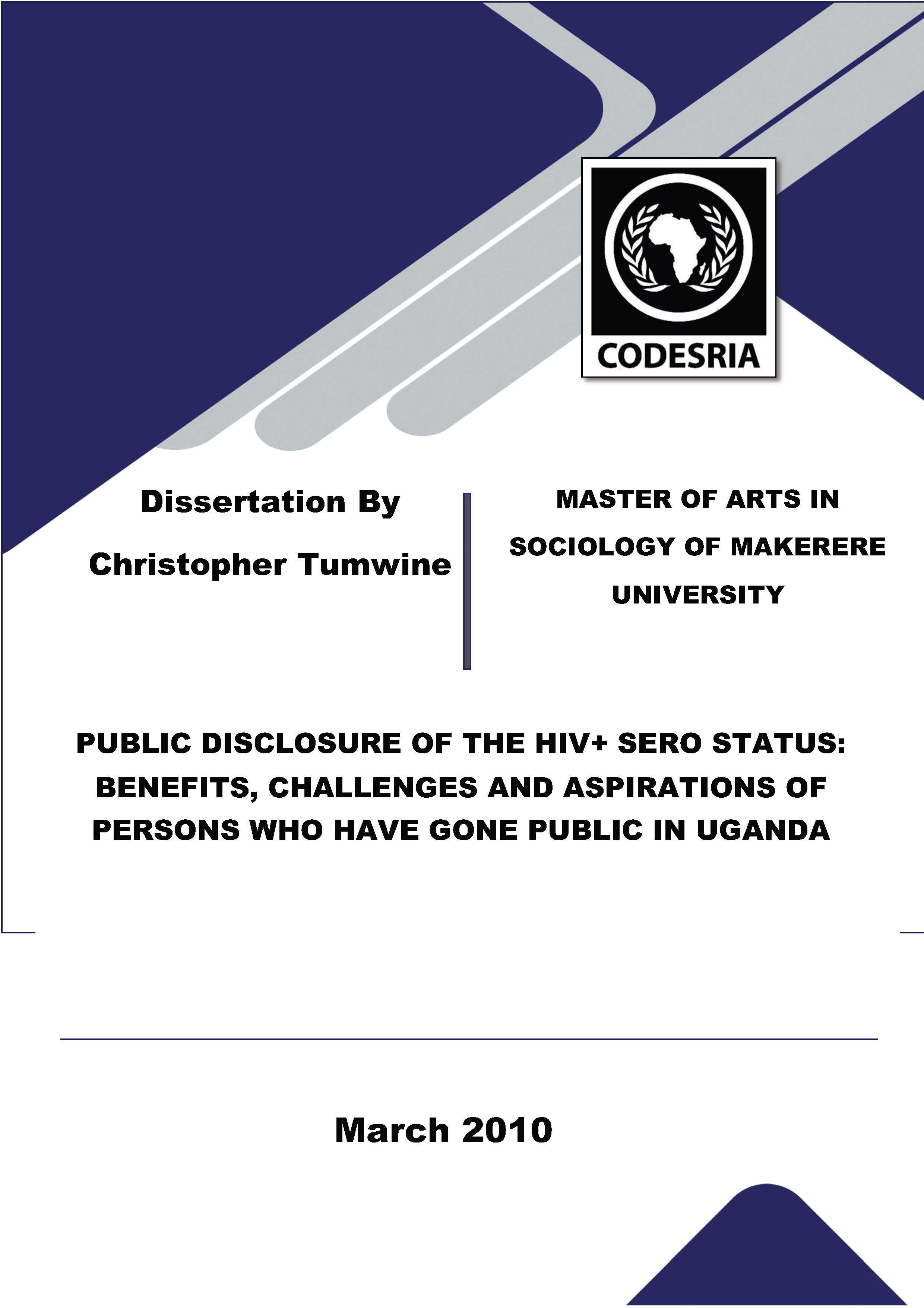PUBLIC DISCLOSURE OF THE HIV+ SERO STATUS: BENEFITS, CHALLENGES AND ASPIRATIONS OF PERSONS WHO HAVE GONE PUBLIC IN UGANDA
Mots-clés :
HIV, aids, health, public disclosureSynopsis
Background: Although disclosure of the HIV+ status can happen at four different levels –to a partner, family, friends and to the public, previous investigations in Uganda have concentrated on benefits and challenges from the first three levels (to a partner, family, friends) at which disclosure can happen.
Methods: To examine the benefits, challenges and aspirations of persons that have gone public, in-depth interviews with 30 individuals that have disclosed to the public were conducted.
Results: Benefits out of public disclosure to the community include, debunking myths and misconceptions about HIV/AIDS, notifying potential partners, educating both HIV negative and positive people about how to reduce the spread of HIV. Collective shame is the major challenge met by some groups from which individuals who disclose come. Benefits to individuals disclosing are; economic, treatment and intrinsic benefits, reduction of re-infection, and reduction of discrimination and stigmatisation. Major challenges to the individual include discrimination and stigmatisation from many sources, failure to be believed by the communities they disclose to and the necessity to change “careers”. The aspirations that individuals who disclose to the public get after disclosing include, the desire to encourage more of positive persons to disclose, continuing the fight against discrimination and stigmatisation in whatever way is possible and working to strengthen organisations and institutions involved in the response to HIV/AIDS.
Conclusions: The challenges the individual who discloses and the community disclosed to meet, are currently less than the benefits they get from public disclosure. In view of this, programmatic efforts should focus on increasing public disclosure through drama group initiatives in an attempt to promote HIV prevention and treatment.
The objectives of the study were; to examine the process to public disclosure. To examine the benefits (both to the individual and the communities from which they come) that arise out of the act of public disclosure. To establish the challenges (both to the individual and the communities from which they come) that arise out of the act of public disclosure. To establish the aspirations (largely of the individual disclosing) that arise as a result of the act of public disclosure.
In order to achieve the above objectives in-depth interviews with 30 individuals that have been able to disclose to the public were carried out to gather the data. In addition to individuals that have been able to disclose to the public, 6 counsellors who are involved in the outreach programme at TASO which is charged with the responsibility of sensitizing communities about the reality of HIV/AIDS were interviewed as key informants.
Public disclosure is part of the disclosure process and in most circumstances is the last phase of the disclosure process. In limited circumstances, public disclosure is able to happen without the lower levels (individual, the family) not being aware, but the ultimate result is that the important stakeholders finally get to realize that a certain individual is HIV positive, even when they disclose first to the public before disclosing to the family. Three categories of people were identified when the act of public disclosure was considered, the first category was that of people who even with the support of an organized group can never accept to go public, then the second category of people are those who with the support of an organized group can be able to go public, and the third category of people are those who have not waited and do not need the support of organized groups to go public.
Téléchargements
Références
Abadı´a-Barrero, C.s.E., & Castro, A. (2005). Experiences of stigma and access to HAART in children and adolescents living with HIV/AIDS in Brazil. Social Science and Medicine, 62(2006), 1219-1228.
African Women in Science and Engineering, American Association for the Advancement of Science, Jomo Kenyatta University of Agriculture and Technology, Association of American Colleges and Universities, & International Women in Science and Engineering (2001). Women in Higher Education and Science: African Universities Responding to HIV/AIDS, A Report from a Workshop. Nairobi.
BBC (2005). Uganda 'not dropping' Aids condom.
Berger, P.L. (1963). Invitation to Sociology: A humanistic perspective London: Penguin Books Ltd
Black, B.P., & Miles, M.S. (2002). Calculating the Risks and Benefits of Disclosure in African American Who Have HIV. Clinical Studies, 31(6), 688-697.
Bor, R., du Pleiss, P., & Russell, M. (2004). The Impact of Disclosure of HIV on the index patient's self-defined family. The Journal of Family Therapy, 26(2), 167-192.
Brinkerholf, D.B., & White, L.K. (1988). Sociology. St. Paul: West Publishing Co
Bryman, A. (2004). Social Research Methods New York: Oxford University Press
Cambridge University Press (1996). Cambridge International Dictionary of English. Cambridge: Cambridge University Press.
Collins (1993). Collins English Dictionary and Thesaurus. Glasgow: Harper Collins Publishers.
Cusick, L., & Rhodes, T. (1999). The process of disclosing positive HIV status: findings from qualitative research. Culture, Health and Sexuality, 1, 3-18.
Flynn, M. (2002). Flight of men.
Gary, M., & Nicole, C. (2000). HIV-Postive Men's Sexual Practices in the Context of Self Disclosure of HIV Status. Journal of Acquired Immune Deficiency Syndromes, 27(1), 79-85.
Gilmore, N., & Somerville, M.A. (2000). Stigmatisation, Scapegoating and discrimination in sexually transmitted diseases: overcoming 'them' and 'us'. . Social Science and Medicine, 39, 1339-1358.






